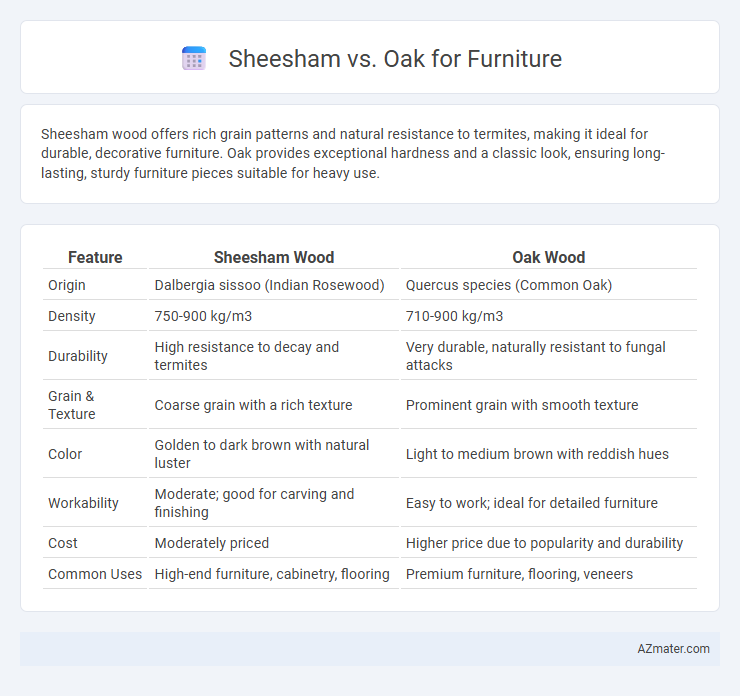Sheesham wood offers rich grain patterns and natural resistance to termites, making it ideal for durable, decorative furniture. Oak provides exceptional hardness and a classic look, ensuring long-lasting, sturdy furniture pieces suitable for heavy use.
Table of Comparison
| Feature | Sheesham Wood | Oak Wood |
|---|---|---|
| Origin | Dalbergia sissoo (Indian Rosewood) | Quercus species (Common Oak) |
| Density | 750-900 kg/m3 | 710-900 kg/m3 |
| Durability | High resistance to decay and termites | Very durable, naturally resistant to fungal attacks |
| Grain & Texture | Coarse grain with a rich texture | Prominent grain with smooth texture |
| Color | Golden to dark brown with natural luster | Light to medium brown with reddish hues |
| Workability | Moderate; good for carving and finishing | Easy to work; ideal for detailed furniture |
| Cost | Moderately priced | Higher price due to popularity and durability |
| Common Uses | High-end furniture, cabinetry, flooring | Premium furniture, flooring, veneers |
Introduction to Sheesham and Oak Wood
Sheesham wood, also known as Indian Rosewood, is renowned for its rich grain patterns, durability, and natural oils that enhance resistance to decay, making it a popular choice in traditional and high-end furniture craftsmanship. Oak wood, typically sourced from the Quercus species, is prized for its strength, hardness, and prominent grain, offering a sturdy and long-lasting material favored in both rustic and modern furniture designs. Both woods present unique aesthetic and structural qualities that influence their use in furniture, with Sheesham known for its warm hues and Oak for its robust texture and versatility.
Origin and Availability of Sheesham and Oak
Sheesham, also known as Indian rosewood, originates primarily from the Indian subcontinent, including India, Pakistan, and Nepal, making it a popular choice in South Asian furniture markets. Oak, native to the temperate regions of the Northern Hemisphere, especially North America and Europe, is widely available in Western countries with extensive commercial plantations. The availability of Sheesham is often regional and limited compared to the more abundant and sustainably managed oak forests across Europe and North America.
Physical Properties: Grain, Color, and Texture
Sheesham wood features a striking grain pattern with rich shades ranging from golden brown to deep reddish hues, creating a warm and inviting appearance ideal for furniture. Oak offers a prominent, coarse grain with light to medium brown colors, often accented by subtle variations that enhance its classic, sturdy aesthetic. The texture of Sheesham is smooth and dense, providing durability and a fine finish, while Oak presents a more open texture that contributes to its robust strength and resistance to wear.
Durability and Strength Comparison
Sheesham wood, known for its high natural oil content, offers superior durability and resistance to decay compared to traditional Oak, making it ideal for long-lasting furniture. Oak, especially white oak, provides exceptional strength and hardness, ensuring structural stability and resistance to wear in heavy-use environments. Both woods exhibit excellent durability, but Sheesham's natural oils give it an edge against moisture and insect damage, while Oak's dense grain enhances its load-bearing capacity.
Workability: Ease of Crafting and Shaping
Sheesham wood offers superior workability with its fine grain and moderate density, making it easier to carve and shape intricate designs compared to Oak. Oak's dense and coarse texture can pose challenges during crafting, requiring more effort and specialized tools for detailed work. Both woods provide durability, but Sheesham is preferred for custom, ornate furniture due to its smoother machining properties.
Maintenance and Care Requirements
Sheesham wood requires regular oiling and dusting to maintain its natural sheen and prevent drying or cracking, benefiting from a humid environment to avoid warping. Oak furniture demands consistent cleaning with a soft cloth and occasional polishing to protect its dense grain and maintain durability against scratches and moisture. Both woods need protection from direct sunlight and extreme humidity to preserve their structural integrity and appearance over time.
Cost Differences: Sheesham vs Oak
Sheesham wood is generally more affordable than oak, making it a popular choice for budget-conscious furniture buyers without compromising durability. Oak, known for its strength and long lifespan, commands a higher price due to its density and grain patterns. Sheesham's lower cost aligns with its availability and faster growth rate compared to the slower-maturing oak species.
Environmental Impact and Sustainability
Sheesham, or Indian rosewood, is a sustainable choice due to its rapid growth and natural resistance to pests, reducing the need for chemical treatments, whereas oak typically requires longer harvesting cycles impacting forest sustainability. Sheesham's durable quality ensures furniture longevity, minimizing waste, while oak, often sourced from slower-growing deciduous forests, may contribute to deforestation if not responsibly managed. The environmental footprint of Sheesham is lower when sourced from certified plantations compared to oak harvested from non-certified forests, making Sheesham a more eco-friendly option for sustainable furniture production.
Best Uses for Sheesham vs Oak Furniture
Sheesham wood is best suited for intricate carved furniture, decorative pieces, and traditional designs due to its rich grain patterns and durability. Oak furniture is ideal for heavy-use items like dining tables, chairs, and flooring because of its strength, hardness, and resistance to wear. Both woods excel in indoor furniture, but Sheesham offers better moisture resistance for humid environments, while Oak is preferred for classic, sturdy furniture with a lighter finish.
Choosing the Right Wood: Key Considerations
Sheesham wood offers natural resistance to decay and rich grain patterns, making it ideal for ornate furniture requiring durability and aesthetic appeal. Oak, known for its hardness and classic light to medium brown tones, provides excellent strength and wear resistance suitable for heavy-use pieces such as dining tables and flooring. Choosing between Sheesham and Oak depends on factors like moisture resistance, wood grain preference, maintenance needs, and the intended furniture function.

Infographic: Sheesham vs Oak for Furniture
 azmater.com
azmater.com